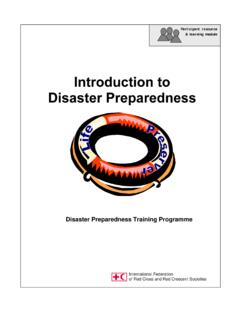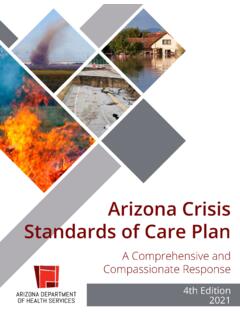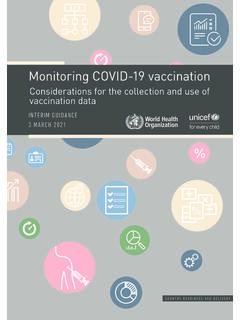Transcription of JULY 2018 Hospital Preparedness for Unplanned …
1 Hospital Preparedness for Unplanned information technology downtime EventsA Toolkit for Planning and ResponseJULY 2018 Hospital Preparedness for Unplanned information technology downtime events | MGH Center for Disaster Medicine Executive Summary ..4 Introduction ..5 Recognizing the Scope of the Issue ..7 Risk Assessment and Mapping ..7 Recognizing Vulnerable Processes ..8 Prospectively Identifying Specific Threats to Patient Safety During Downtimes ..8 Anticipating the Magnitude of Operational Throughput Disruptions ..8 Enhancing Collaborative Planning.
2 10 The downtime Planning Committee ..10 Developing Multidisciplinary response Teams ..12 The Tier One response Team (iDART) ..13 The Tier Two (DART) Team ..14 The Tier Three (HICS) response ..15 Improving response Tools ..19 Developing Appropriate Resources ..19 Ensuring Efficient Communication ..22 Redundant and Effective Communication Systems ..22 Sending Accurate and Timely Messages ..22 Responding to Extended events ..23 Speeding Patient Safety Considerations during Reconciliation ..24 Coordinating the Recovery Process.
3 24 Service Recovery ..25 Training and Exercises ..26 Exercises ..26 Evaluation ..27 Conclusion / Summary ..28 CONTENTSH ospital Preparedness for Unplanned information technology downtime events | MGH Center for Disaster Medicine Appendix I: Summary of downtime Planning and response ..29 Appendix II: Developing a downtime Planning Committee ..30 Appendix III: Developing a downtime Assessment and response Team ..31 Appendix IV: Sample downtime response Communication V: Sample downtime response Messaging ..33 Appendix VI: Sample downtime response Briefing Agenda.
4 34 Appendix VII: Sample downtime Event Status Report ..35 CONTENTS CONTINUED/// Executive SummarySince 2008, use of information technology (IT), including electronic health records (EHRs), has increased more than eight-fold in Additionally, healthcare s increasing reliance on IT is not limited to support of direct patient care activities, but commonly now extends to nearly every aspect of daily operations, from supply chain management, nutrition services, finance, and beyond. Yet, while this increasing use of IT offers many benefits, one critical assumption on which these well-documented advantages are based is the uninterrupted operational status of the systems and technologies in use.
5 When IT services fail, Unplanned downtime events occur and each of the putative benefits of IT systems (such as improvements in speed and efficiency, integration of information , reduction of errors, and communication), can become an area of major vulnerability for the Hospital . Without functioning IT systems, Hospital throughput and efficiency immediately decline, communication is challenged, and carefully designed safety systems are often unavailable. In many cases hospitals abilities to manage their Unplanned IT downtime events have substantially lagged behind their adoption of new technologies.
6 Yet, because of the potential impact on Hospital operations, Unplanned IT downtime events can be just as serious a threat to patient safety as a power outage or medical gas failure. Therefore, it is essential that hospitals close this gap in emergency Preparedness . 1 Charles, D., Gabriel, M., Searcy T. (April 2015) Adoption of Electronic Health Record Systems among Non-Federal Acute care Hospitals: 2008-2014. ONC Data Brief, Office of the National Coordinator for Health information technology : Washington the Scope of the IssueCollaborative Planning Multidisciplinary response TeamsImproving response ToolsEnsuring Efficient CommunicationSpeeding Recovery Training and Exercise Hospital Preparedness for Unplanned information technology downtime events | MGH Center for Disaster Medicine 4 This toolkit is designed to assist hospitals and other healthcare organizations with improving their readiness for Unplanned IT downtime events and is organized with the sections listed here.
7 /// IntroductionHospitals and other healthcare organizations in the are adopting and utilizing information technology systems at an unprecedented pace. A recent survey of non-Federal acute care hospitals found that approximately 97% of hospitals now possess certified EHR technology , marking a 35% increase just since This increasing adoption of IT in healthcare has been referred to as a proverbial double-edged sword (Palmieri et al, 2011), noting that IT introduces solutions to improve performance while simultaneously generating new potential problems, or technical iatrogenesis in already complex healthcare systems, especially when the new technology In addition, IT failure events in healthcare can be extremely complex, with far-reaching, and sometimes unanticipated, disruptive consequences within an organization.
8 As technology becomes an ever-more essential component of the delivery of modern medical care , healthcare entities must ensure that they have extremely robust and well-conceived operational plans in place to be able to identify the full extent and consequences of any outage as rapidly as possible. Healthcare providers must be prepared to support maximally safe and efficient clinical processes when their IT systems become unavailable. For the purposes of this toolkit, we define an Unplanned IT downtime event as any unexpected event where a technology system is unavailable, or fails to perform as designed.
9 While many such IT downtime events are minor, either being invisible to end users and/or being fixed within minutes, some events have a much greater impact on clinical care and Hospital operations, and these events can significantly threaten both the efficiency of clinical operations and the safety of the care delivered. Unfortunately, and importantly, it must be noted that the difference between major and minor downtime events is not always immediately clear, and it can require substantial effort to investigate both the full scope and the root cause of some Unplanned downtime events in critical factor to successfully preparing for and managing IS downtime events in a healthcare environment is a having a strong system that supports and encourages collaboration among three key groups.
10 IT experts, Hospital operational leaders (such as nursing supervisors, administrators and others), and Hospital emergency managers. These separate, but interconnected, groups must plan together, respond together, and recover together. ITOperationsEmergency Mgt2 Charles, D., Gabriel, M., Searcy T. Adoption of Electronic Health Record Systems among Non- Federal Acute care Hospitals: 2008-2014. ONC Data Brief, Office of the National Coordinator for Health information technology . April 2015. Washington Palmieri PA, Peterson LT, Ford EW.

















